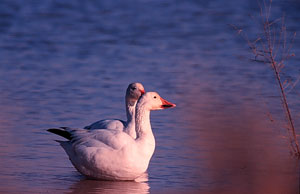Invasive Pathogens and Emerging Diseases of Wildlife in the United States
Emerging wildlife diseases have become a high-priority concern in the United
States and throughout the world because of the potential for spreading dangerous
diseases to humans, because of economic losses associated with livestock morbidity
and mortality, and because of the harmful effects on natural wildlife populations
and ecosystems. International trade in animal and plant species, human population
increases, and reduced wildlife habitat have created a situation in which
wildlife species can be considered 'reservoirs' of pathogens dangerous to
humans and livestock at the same time these populations are themselves endangered
by introduced pathogens. This project addresses several of the most critical issues
impacting United States and North American wildlife.
This project is managed by the USGS National Wildlife Health Center in Madison, WI.
Project Tasks:
- The epizootiology and distribution of West Nile virus in the U.S.
- Development of epizootiologic models and related analytical support
for Chronic Wasting Disease in white-tailed deer and other cervids.
- Impacts of invasive wildlife diseases and role of wildlife as reservoirs and vectors.
- National surveillance of the West Nile virus.
- West Nile virus in waterfowl: Prevalence & susceptibility to experimental inoculation.
- Experimental investigation of the susceptibility, pathogenesis, and immune response of avian
species to West Nile virus.
- Measuring the effects of West Nile virus on ruffed grouse and American woodcock in Minnesota.
- Measuring the effects of West Nile virus on wild American kestrel populations in Colorado.
- Chronic Wasting Disease: Technical assistance to States, Tribes, and Federal Agencies.
- Biology of CWD prions and factors affecting their environmental persistence.
- West Nile virus and other pathogens in sage grouse.
Project Research:
For more information on any of the tasks listed above, please contact Gail Moede-Rogall at 608-270-2438 or via email at gamoede@usgs.gov
|

Photo by Milton Friend
Objectives:
- Understand associations between host, agent and environment that lead to disease emergence, expansion or escalation.
- Identify critical areas for emerging wildlife diseases where control and prevention efforts should be targeted.
- Document baselines for wildlife disease patterns and trends so that changes/shifts in disease patterns and trends can be identified.
- Increase capability to identify and respond quickly and effectively to emerging wildlife disease outbreaks.
|
|